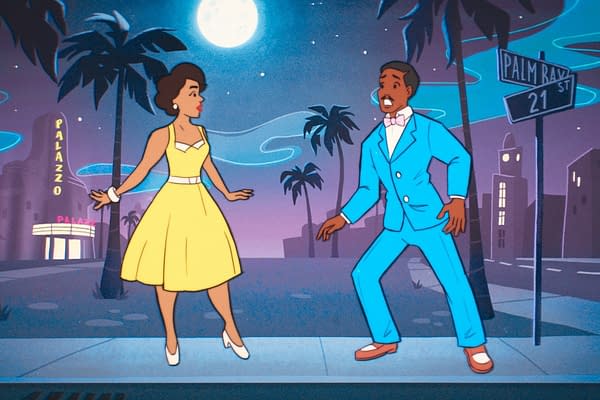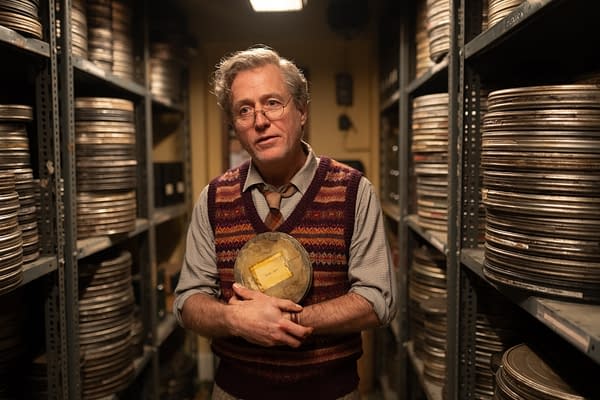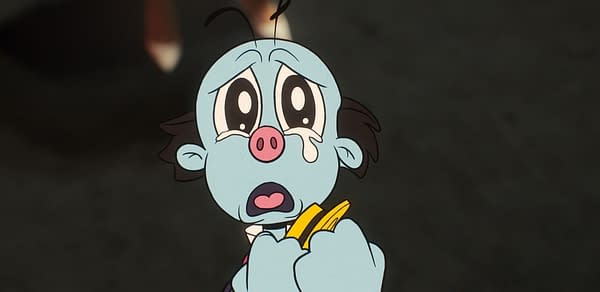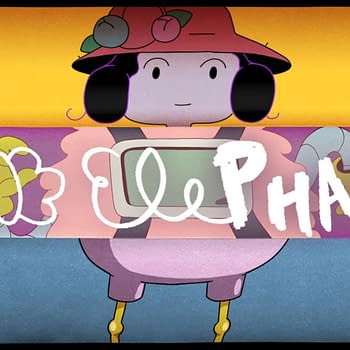Posted in: BBC, Doctor Who, TV | Tagged: doctor who
Doctor Who: Our Deep Dive Into The Disney Era-Defining S02E02 "Lux"
Here's our deep dive into the Disney+/BBC Era-defining Doctor Who S02E02: "Lux," with all the crazy meta themes that fold in on themselves.
Let's dive into the second episode of Doctor Who, "Lux". This is going to be all spoilers with the assumption that you've watched the episode. This is the craziest and most fun episode of the series' Disney era and arguably the best. Russell T. Davies is swinging big with this episode, and many fans have been hyped for it. The Doctor fights a cartoon character in a combination of live action and animation that's been a convention in cartoons since the 1940s, but not done often because melding live action with cartoons is often expensive and hard to get right, all the way to Who Killed Roger Rabbit?. The makers of the episode are rightfully proud of it because the animated character Mr. Ring-a-Ding is hand-drawn rather than CGI-generated to replicate the classic cartoons of the 1930s to the 1950s. Just so you know, there are MAJOR SPOILERS ahead…

Playing Dress-Up Again
The Doctor is trying to get Belinda back to Earth on May 24th by taking the long way, bouncing through past and future to latch onto the date they're after, unaware that the Earth has been destroyed by that date. The Doctor leads Belinda to the dressing rooms with the closets (still unseen) in the TARDIS to emerge dressed in cool 1950s clothes in a deliberate callback to the beginning of episode two of season one, where the Doctor and Ruby run into the TARDIS hallways and emerge in Swinging Sixties London fashion.

The Politics of Miami-Dade 1952
We're in Cold War America and the South. The Doctor mutters it might be wise to wander around Miami, 1952, at night out of sight of most people, because he and Belinda are safer there. "Things are different at night." Secret things happen at night, good and bad. They notice Rock Hudson is a big movie star, still closeted, and Belinda learned of his death from HIV infection. He's aware that racist segregation laws were in effect. There's some push-and-pull with the tension, which the script often easing up to let The Doctor and Belinda go through the story more smoothly – they're lucky that the busboy and patrons at the diner aren't racists and fine with interacting with them rather than report them since being in the diner as people of colour is a crime. A cop who shows up to threaten them later in the cinema turns out to be a construct by Mr. Ring-a-Ding to distract them from fighting him. Unlike in season one, this is a Doctor who can navigate places where his skin colour could place him at a disadvantage.

Continuity Callbacks and the Doctor's Mythology
The show's recent continuity and mythology kick in here, and surprisingly seamlessly. Why shouldn't you make Mr. Ring-a-Ding laugh? Because it sounds like The Giggle, which is the harbinger of the arrival of another deadly god to challenge The Doctor. The Doctor blurred the boundaries between Science and Myth at the edge of the universe in "Wild Blue Yonder", which enabled The Toymaker to return and wreak havoc in "The Giggle", then the Toymaker's child, Maestro the God of Music, in "The Devil's Chord" in season one. What's revealed again is that the gods steal what they represent – where Maestro stole music, Lux, the God of Light, wants to steal light. In the guise of Mr. Ding-a-Ling, the God of Light wants to steal the Doctor's infinite life. Life seems to be what the gods covet most, and since the Doctor killed Sutekh, the God of Death, they became the God of Life, which actually explains why the Doctor regenerates endlessly. The God of Life is Life Itself and thus can never die. The Doctor will always regenerate, return. That's the Doctor's entire mythology hiding in plain sight since Chris Chibnall retconned the Doctor's origin in "The Timeless Child". If the Doctor is the God of Life, of course, they're always part-child, part-ancient, embodying both Young and Old.
Gods Have to Follow Rules
The gods have declared war on The Doctor. Thanks to The Doctor temporarily thwarting the nameless ones in "Wild Blue Yonder" by distracting them into counting rice, the gods are bound by rules when they enter the universe. They are bound by the rules to tell the Doctor their intentions. Lux, the god of light, is trapped in the form of Mr. Ring-a-Ding and has to follow the rule of re-enacting his song-and-dance routine when the reel of his cartoon is playing, which is how Reginald Pye keeps him at bay.

Into the Tooniverse
Of course, the Doctor and Belinda become cartoons in the style of the Scooby-Doo series from Hanna-Barbera. They have the same body language and types of simplistic lines, but escape being toonified by revealing their fears to each other for the first time. Becoming more nuanced makes them more than two-dimensional and returns them to three-dimensional live action. It's a funny way to reveal their feelings to each other and start to become closer by making it essential to the story.

Breaking the Biggest Fourth Wall of All
The biggest surprise of "Lux" is that Davies goes there when you least expect it. It's the one thing no one could possibly predict. It's like Davies tapping into Gogglebox (a long-running UK TV reality series on Channel 4 where real-life households are filmed watching and reacting to TV shows). The Doctor and Belinda discover another reality where they're in a TV show watched by devoted geeks Lizzie, Hassan, and Robyn. Those geeks are us, Doctor Who fandom, and a commentary on fandom. Davies is acknowledging fans openly here. He has admitted to watching their reaction videos, lurking on fan forums, and following their social media accounts. Lizzie, Hassan, and Robyn make references and commentary that fans have been saying online for years, including the joke about their favourite episode being "Blink".

Is "Doctor Who" Real or Are the Fans Real? Or Both? Or Neither?
Characters breaking the Fourth Wall and interacting with readers and fans within the story have been a common trope of pop culture going all the way back to American comic books in the 1940s. This is just the newest representation of that. Lizzie, Robyn, and Hassan have already watched this episode, and not only do they know they're not real, but they also spoil the rest of the plot for the Doctor and Belinda to know how to defeat Mr. Ring-a-Ding. The meta becomes time-wimey here and a Fourth Wall reversal: here they're fictional constructs created by Mr. Ring-a-Ding, and the Doctor and Belinda are real, and they would cease to exist when the Doctor and Belinda return to the "real" world of the story. And composer Murray Gold's soundtrack starts to use riffs from the Matt Smith era, specifically. The Doctor and the fans saying goodbye to each other could also be referencing the series' rumoured coming hiatus.
You could accuse Davies of pandering to fans, and what popular show doesn't? It's just doing it by breaking through the Fourth Wall. Doctor Who is over 60 years old due to its massive fandom, so why not address that in a plot-driven way – the fans give the Doctor and Belinda spoilers for how to defeat Mr.Ring-a-Ding. Except here, the Doctor and Belinda are real, and the fans are illusions created by the God of Light, who became sentient due to their love of Doctor Who. The fans fade away, and of course, the Doctor would weep at the loss of his fans who want to save him. This feels more earned and poignant than Sasha-55's death last week because she was just a redshirt we knew nothing about to be able to care for.

Loss Continues to be the Recurring Theme of the Series
Once again, loss runs through the story as part of the plot and the recurring theme in the series. Fifteen people are lost in the cinema, and the town mourns them. The Doctor consoles the mother of a boy who is among the living. Reginald Pye, the projectionist (whose name and demeanour as played by Linus Roache might be a reference to Mervyn Peake's gently satirical fantasy novel Mr. Pye) is mourning his wife and Mr. Ring-a-Ding uses a contruct of her to keep him enslaved. The Doctor and Belinda grieve the loss of fans Lizzie, Robyn, and Hassan. The Doctor of Loss indeed. Mr. Ring-a-Ding loses his body and entire sense of self when he dissolves into one with all the light in the universe.

Becoming One with the Universe
Mrs. Ring-a-Ding, like Pinocchio, wants to be a real boy after all. He tries to use the Doctor's bi-generation energy to create a real body, not made of light, and in 3D, he looks hideous and terrifying instead of goofy and funny in line-drawn 2D. His motivation seems to be shifting, as fan Hassan points out. He's also vampiric and demonic, as he has to be confined to the inside of the cinema to avoid getting too much light from the sun, and when he absorbs the light to grow infinitely, he dissolves into the universe, becoming both everything and nothing. The god of light becomes all light. In Buddhism, Transcendence and Enlightenment mean letting go of the ego to become nothing. His victory is also his defeat. Very Zen. It pays off the hint of poignance he displayed earlier.
There's Always a Twist at the End
A wild Mrs. Flood (Anita Dobson) appears. She can now time travel and seems to be stalking The Doctor across Space and Time because, of course, she is. And like the fans, she seems to know the spoilers. She points the locals to watch the TARDIS disappear like the heroes riding off into the sunset at the end of a movie. Her remark that the show will end on May 24th, the day The Doctor and Belinda are trying to return to Earth because the Earth was already destroyed, could also refer to the series' rumoured upcoming hiatus if you want to read that much into it.

And lo, Lizzie, Robyn, and Hassan didn't fade out of existence after all. They get to continue watching Doctor Who! You might ask how? Well, the Doctor is the God of Life after all, and in coming into contact with him, he has given them life, emotionally, spiritually, and physically. This is metaphorical: the Doctor saves fans and fans save the Doctor. That's how it's always been. Fandom is a religion, and Doctor Who is one of its many churches. Fans are canon now, but aren't they always?
Doctor Who is streaming on Disney+ outside the UK.














